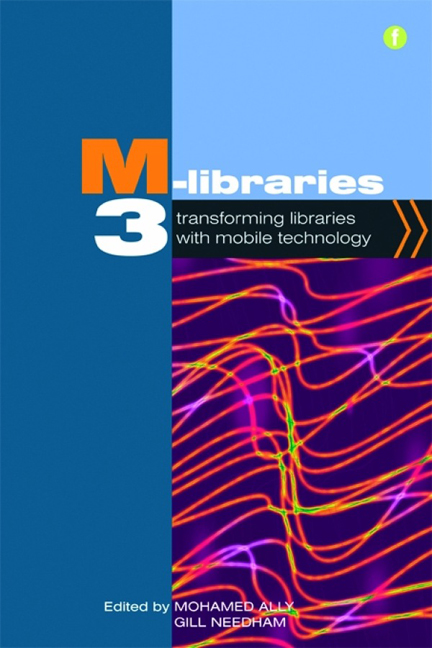Book contents
- Frontmatter
- Contents
- Acknowledgements
- Contributors
- Foreword
- Introduction
- 1 Education for all with mobile technology: the role of libraries
- PART 1 DEVELOPING MOBILE SERVICES
- PART 2 PEOPLE AND SKILLS
- PART 3 FOCUS ON TECHNOLOGY
- 15 Mobile services of the National Library of China
- 16 India's mobile technology infrastructure to support m-services for education and libraries
- 17 Use and user context of mobile computing: a rapid ethnographic study
- 18 Meeting the needs of library users on the mobile web
- 19 Mobile dynamic display systems for library opening hours
- 20 Device-independent and user-tailored delivery of mobile library service content
- 21 Designing effective mobile web presence
- Conclusion
- Index
16 - India's mobile technology infrastructure to support m-services for education and libraries
from PART 3 - FOCUS ON TECHNOLOGY
Published online by Cambridge University Press: 08 June 2018
- Frontmatter
- Contents
- Acknowledgements
- Contributors
- Foreword
- Introduction
- 1 Education for all with mobile technology: the role of libraries
- PART 1 DEVELOPING MOBILE SERVICES
- PART 2 PEOPLE AND SKILLS
- PART 3 FOCUS ON TECHNOLOGY
- 15 Mobile services of the National Library of China
- 16 India's mobile technology infrastructure to support m-services for education and libraries
- 17 Use and user context of mobile computing: a rapid ethnographic study
- 18 Meeting the needs of library users on the mobile web
- 19 Mobile dynamic display systems for library opening hours
- 20 Device-independent and user-tailored delivery of mobile library service content
- 21 Designing effective mobile web presence
- Conclusion
- Index
Summary
Introduction
The growing need for high mobility and to stay connected is the prime driver of increasing mobile use in the world today. This is true for people of different age groups and occupations. The youth segment, in particular, comprises 30% of the total mobile handset market. This segment requires high mobility and connectivity, and the same is true for business and other professionals. This innate need, coupled with the availability of handsets and connectivity at affordable prices, has triggered the growth of mobile use in India.
The mobile phone has evolved from being a mere communication device to being an access mode with an ability to tap into a plethora of information and services. This is the reason why it is now being referred to as the ‘fourth screen’, after cinema, television and computers.
M-resources and m-library services have become the ‘pull effect’, and students and researchers increasingly asking for more than just basic telephony in order to access them, driving the development of mobile value added services (MVAS). Today most of the students and faculty in universities and research institutions are seeking more from their communication devices and they are two of the prominent groups that have become increasingly reliant on mobile internet services for research, m-resources, m-educational literature searches and projects.
The growth of MVAS is based on four pillars: access devices, content, technology and infrastructure. This chapter analyses these four pillars and mobile network services in India with regard to the availability of mobile broadband; and mobile service providers with regard to MVAS and their cost-effectiveness for mobile users. The chapter will also present data about the types of mobile content and applications available through different mobile service providers and how it is used and valued by learners in different real-life study contexts. An overview of the mobile web, its potential use with Web 2.0 tools (including screencasts, podcasts, vodcasts and YouTube) and how it is beginning to be employed to support our education system, especially libraries, is also presented.
The total number of mobile subscribers in India as of July 2010 was 652.42 million. Since its liberalization in 1991, the telecoms sector has seen unprecedented growth. It is currently valued at $100 billion dollars, contributing a very significant 13% to GDP.
- Type
- Chapter
- Information
- M-Libraries 3Transforming libraries with mobile technology, pp. 139 - 150Publisher: FacetPrint publication year: 2012



